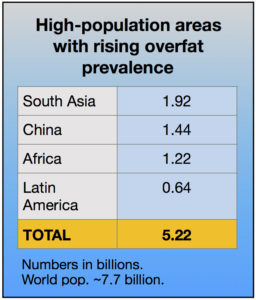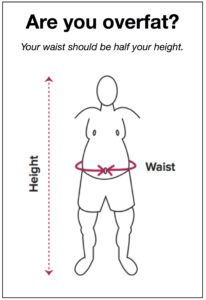
Many not considered obese or overweight by traditional measures fall into this category, and it increases the risk for viral infection.
The prevalence of the global overfat pandemic may be fueling viral infections such as the Novel Coronavirus, according to the lead author of a new scientific review. The research concluded the prevalence of overfat people is significantly greater than originally thought, affecting perhaps 80 percent of the world’s population.
“Excess body fat is an important and little discussed risk factor in infectious viral diseases,” says Dr. Philip Maffetone. “The earliest scientific data from China on COVID-19 shows that those most vulnerable to the infection includes people with diabetes, hypertension, cardiovascular disease and chronic inflammation — conditions caused by excess body fat.”
Excess body fat sufficient to impair health — overfat — is a serious but hidden pandemic. Overfat is a primary cause of chronic disease, physical disability, reduced quality of life, and increased healthcare costs, and now includes viral infections. Overfat can occur in those who are overweight, obese, and in 40 percent of those who are normal-weight.
But those who are overfat may be more likely to contract viruses, and are less responsive to vaccines.
“Excess body fat can impair our immune system, increase chronic inflammation, and make us more vulnerable to infections,” Maffetone says.
Maffetone and co-researcher Paul Laursen, who first described the global overfat pandemic in 2017 (Overfat and Underfat: New Terms and Definitions Long Overdue) used new studies to conclude that their original estimation was very low at 76 percent of the world’s population.
The new study, published in the journal Frontiers in Public Health, highlighted densely populated areas of South Asia and China with rapidly rising overfat rates, along with Latin America and Africa — areas that make up the majority of the world’s people (see chart below). Maffetone previously led research showing that 80 percent of adults in India, and 91 percent in the U.S., are overfat.
Maffetone emphasizes that while the common belief is a lack of exercise is a key cause of excess body fat, the overfat condition actually has ballooned despite increasing numbers of people who exercise. “This paradox is observed globally not only in the general population, but in athletes and even the military,” he says.
Rather, the largest contributing factor to the global overfat pandemic is increased consumption of processed carbohydrates, especially added sugar. “A high amount of this carbohydrate converts to fat that’s stored in the body, while at the same time it impairs our ability to burn body fat for energy, so it stays stored,” Maffetone said.
While BMI, along with the bathroom scale, are common measures of overweight and obesity, they cannot determine if one is overfat. Measuring the waist-to-height ratio is a better indicator — the waist should be less than half the height in inches or centimeters. (See graphic below.)
The new study does not estimate the global overfat prevalence, but does emphasize that public health officials and clinicians worldwide already have sufficient, cost-effective assessment and treatment tools available to reverse this preventable condition. Individuals can also manage the problem by avoiding junk food, especially sugar and other refined carbohydrates.
While we uncover new risk factors whenever a new infectious pandemic occurs, we finally know now that excess body fat raises the risk of viral infections, and worsens the outcomes in infected patients.










